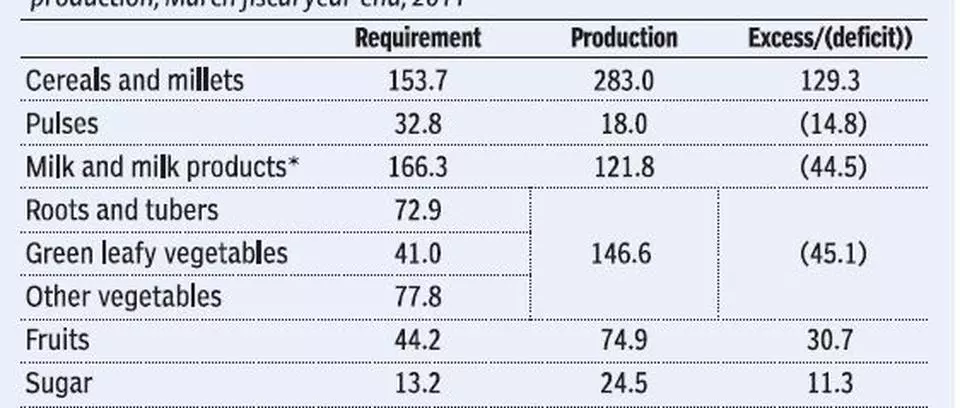Meeting change in food habits
The Hindu Business Line
India needs to diversify its agriculture, break out of the cereals trap

India needs to diversify its agriculture, break out of the cereals trap
The country's agriculture has mostly revolved around inputs required to make farming viable and successful.
But it is high time that agriculture is viewed from the perspective of the output that country wants from the sector.
Nutrition guidelines that the National Institute of Nutrition (NIN) lays down specify food calories and portions for individuals in various age, gender and work categories.
NIN guidelines go into great detail on the quantum of calories that Indians of various work-profiles and gender need and the food source from which such calories should come from.
Looking at the NIN-recommended portions of food for each category of people alongside data from census and NSSO, it is easy to determine the country's annual food quantity requirements.
It is worth noting that the peak recommended calorie requirements in India for men and women (3,490 and 2,850 calories respectively) are 15-20 per cent higher than those in the US (3,000 and 2,400).
This analysis hence quantifies the various types of foods that we need and hence what our farmers need to produce.
Of course, our agriculture is not closed for imports or exports but the country is – and strives to be – self-sufficient in agriculture.
We need to take a couple of assumptions into account here: (1) this calculation will assume that everyone in the country gets their recommended dietary allowance (we, of course, know that this is not the case and there is significant inequality in the availability of both the quantity and quality of food and calories) and (2) there is no wastage between production and consumption (and this too is not a very practical assumption).
Unfortunately, both these points are linked: if there were lesser wastage of food in the supply chain, fewer will go hungry or lose out on essential nutrients.
Having put in place the basic framework, we note that India currently produces a lot more of cereals than it needs and much less milk and vegetables (see table).
It is also evident that the country produces almost twice its nutritional requirement of fruits and sugar.
Fruits have been a large contributor to food inflation but the country seems to grow far more than it needs (exports cannot explain such a large difference).
This would underscore concerns about (1) harvests that never reach the table thanks to problems with quality, storage and transportation; or (2) simply be faulty data.
Historically, governments have found it easy to procure and distribute foodgrains.
The government keeps the support price of cereals high, which makes it remunerative for marginal farmers to produce them. Similarly, given that India’s subsidised public distribution system (PDS) offers mainly cereals by way of food, perforce, it becomes the food of choice for low economic groups.
The country needs to break out of this cereal trap and diversify its agriculture.
As it becomes richer and a more services-dominated economy, its food requirement will dramatically alter and in turn, will and should impact its production profile.
This is predicated upon both: the changes in occupation structures as more people move out of agriculture and into services and the increasing prosperity of the citizens, making them demand more variety on their plate.
This calculation takes into account the food requirement for humans.
As the citizens become more prosperous and eat more meat, it will result in an increase in cereals cultivation for fodder.
Meeting the country's changing food needs calls for new thinking on agricultural infrastructure as well as incentives.
If India is to feed its burgeoning population, policies must allow price signals to work, make it easier for farmers to sell their insubstantial land holdings (via better property records and liquid markets), incentivise processing of horticulture produce and create strong supply chains.
The writer is Associate Director, Kotak Securities and Author of ‘The Making of India – GameChanging Transitions’. Views are personal.
Comments
Post a Comment